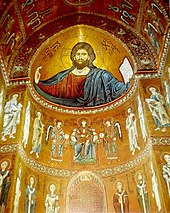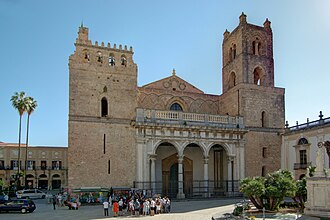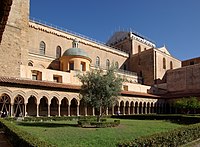Monreale Cathedral
The Cathedral of Santa Maria Nuova in Monreale is the episcopal church of the Archdiocese of Monreale in Sicily . The cathedral, dedicated to the patronage of the Assumption of Mary , is a minor basilica . The cathedral is famous for the Byzantine mosaics and the cloister . Together with the Arab-Norman Palermo and the Cathedral of Cefalù , the church was declared a World Heritage Site by UNESCO in 2015 .
history
The construction of the cathedral, initially designed as a monastery church and memorial building, took place in the years 1172 to 1176. The client was King Wilhelm II of Sicily.
Architectural style
The cathedral shows in a particularly impressive way the Norman-Arabic-Byzantine architectural style , which was widespread in Sicily at that time and represented a symbiosis of three different cultures. The solid structure as a whole is Norman / Romanesque, Arabic style elements can be seen in the blind arches and inlays on the outer walls, especially the apses, and the gold basic mosaics on the inner walls of the cathedral are Byzantine.
Exterior
The cathedral is 102 meters long, 40 meters wide and 35 meters high. Its facade is flanked by two fortified towers, the left tower remaining unfinished and the dome of the right tower was destroyed by lightning in the 16th century.
A classical portico was built in front of the facade in the 18th century , which destroys the facade's original impression. Above the portico, parts of the decor in the Arabic style consisting of overlapping blind arches with inlaid work can still be seen. With a size of 7.8 meters × 3.7 meters, the west portal was the largest portal of its time. The bronze doors were made by Bonannus of Pisa in 1186 . They show 42 scenes from the Bible.
There is also a portico in front of the north side, which fills the rectangular space between the transept and the unfinished bell tower. It was designed from 1547 to 1562 by the brothers Giovanni and Fazio Gaggini on behalf of Cardinal Alessandro Farnese . This is where the side portal (4.23 meters × 2.15 meters) is located, the doors of which, also made of bronze, were made by Barisanus von Trani in 1179 .
The cathedral's apses are best seen in the original decor. Pointed arches overlap and are inlaid with black, white and yellow stone.
Interior
Building layout, walls, floor
The interior of the church is divided into three naves by two rows of nine columns each with Corinthian capitals , with the central nave being more than twice as wide as the side aisles . The chancel in the crossing , the area of intersection of the nave and transept , is particularly emphasized in terms of structure .
The lower part of the walls is covered with marble , which, like the floor, is based on Islamic models. The upper parts of the walls are completely covered with Byzantine gold ground mosaics. The mosaics were created in the period from 1179 to 1182 by local artists and artists from Constantinople and cover a total of 6,340 m². The wooden ceiling was largely renewed after a fire in 1811.
Apses

In the main apse , Christ as Pantocrator (“ruler of the world”) and Our Lady taken up into heaven are depicted. The figure of Christ, seven meters high and thirteen meters wide, occupies the dome of the main apse. In his left hand he holds a Bible, on the open pages of which the beginning of a verse from the Gospel of John ( Joh 8,12 EU : "I am the light of the world. Whoever follows me will not walk in the darkness") in Latin and Read in Greek. The right hand forms the monogram "IC-XC", which can also be found in the lettering on the left and right of the head. In the medallions of the framing arch, Emanuel and the prophets David, Solomon, Elias, Samuel, Daniel, Gedun, Nathan and Eliseus are depicted, next to Our Lady the Archangels Gabriel and Michael with spheres and several apostles . Fourteen more saints are shown in the register below .
The southern apse - also Diakonikon - shows scenes from the life of St. Peter , in the northern apse - also prothesis - there are scenes from the life of St. Paul .
Mosaics
The mosaics on a gold background in the central nave and on the west wall show scenes from the Book of Genesis in two rows , in the upper row the story of creation up to the expulsion from Paradise , in the lower row scenes from the lives of the ancestors Noah , Abraham , Isaac and Jacob .
The mosaics in the choir and transepts depict scenes from the life of Jesus Christ from the Annunciation to the Ascension and the outpouring of the Holy Spirit on Pentecost . The miracles of Jesus Christ are depicted on the walls of the aisles.
Further equipment
In the south transept are the sarcophagi of kings Wilhelm I and Wilhelm II , in the north transept the Margaret of Navarre , the wife of William I, and her sons Roger and Heinrich as well as the empty sarcophagus of King Louis IX. of France . The church has a six-manual organ by Fratelli Ruffatti with 109 stops from 1957 and 1967, which was installed on both sides of the crossing. This instrument is currently the fourth largest organ in Italy.
chapel
In the south is the Chapel of St. Benedict , which was added to the cathedral in 1569 and is now used as the sacrament chapel.
Cloister
The cloister is the only remaining remnant of the Benedictine monastery belonging to the cathedral complex. It has a size of 47 meters × 47 meters.
On each of the four sides of the cloister there are 26 ogival arcades on each side. The pointed arches are supported by double columns. These pillars are designed very differently. Some are simply smooth, others have helical or zigzag-shaped fluting , and still others are adorned with inlays made of mosaic . The capitals are all designed differently, as reliefs depict scenes from the Bible or symbolic Christian and Islamic representations.
In one corner of the cloister there is a square fountain courtyard consisting of 3 × 3 arcades, in the middle of which a circular fountain bowl rests on a column. Another column rises from this bowl, which is provided with zigzag-shaped fluting and ends in a spherical shape, from which the water trickles down along the column.
literature
- Giuseppe Schirò: The Cathedral of Monreale: The city of the golden house of God . Casa Ed. Mistretta, Palermo 2007.
- Brigit Carnabuci: Sicily. Greek temples, Roman villas, Norman cathedrals and baroque cities in the center of the Mediterranean (= DuMont art travel guide ). 6th, updated edition. DuMont Reiseverlag, Ostfildern 2011, ISBN 978-3-7701-4385-6 .
- Rainer Straub: The Singing Stones of Monreale: About the secrets of the Sicilian cloister . Verlag Anton Pustet, Salzburg 2012, ISBN 978-3-7025-0678-0 .
- Lisa Sciortino: Monreale. The cathedral, the mosaics, the cloister . Sime Books, 2012, ISBN 978-88-95218-55-7 .
Web links
- Monreale Monastery (CENOBIUM, a project for the multimedia presentation of Romanesque cloister capitals in the Mediterranean region)
- Homepage of the cathedral (with opening times and entrance fees)
Individual evidence
- ↑ The organ of the cathedral of Monreale on orgbase.nl
Coordinates: 38 ° 4 ′ 54.7 ″ N , 13 ° 17 ′ 31.4 ″ E











